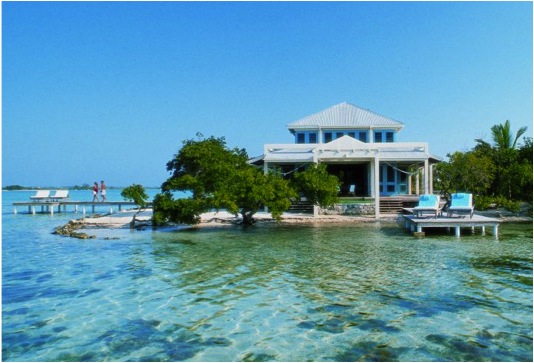Above: Cayo Espanto, Ambergris Caye, Belize
By Alexander Britell
One of three non-island members of CARICOM, Belize is among the gateways to South America for the Caribbean. While the country has suffered from the downturn like the rest of the region, there are some strong signs — from an improving services sector to some stability in the tourism market. Kay Menzies is the President of the Belize Chamber of Commerce and Industry, and the managing director at distribution company Karl H Menzies Co Ltd. Caribbean Journal talked to Kay Menzies, the President of the Belize Chamber of Commerce, about the Belizean economy, some sectors that are showing strength, and what the country can do to bring itself out of the global downturn.
How would you describe the economy right now in Belize?
Like everywhere else, it’s a little bit slow. I think that about sums it up — I’m not sure when matters will pick up again, but we’re sort of reflecting the global economy right now to a large extent.
What sectors have been performing well in relation to the larger economy?
That’s a difficult one. I think that in terms of tourism, it seems to be holding its own a bit. We have our seasonal fluctuation, but they seem to be surviving, if not thriving. And agriculture has good reports in certain sectors. So the strengths are in more of our traditional industries.
Are there any segments of the economy that are not performing as well that should, or could be doing better?
One of the sectors that’s picking up nicely is our services sector. It’s picking up in terms of call centers and so on. We figure that has a lot of growth potential, and it seems to be taking off nicely right now, so that’s good news. What hasn’t thrived as well as it should? Generally, everything is slower than we would like it to be.
What kinds of projects or initiatives is the Chamber working on right now?
Well, we’re primarily an advocacy organization, that also tries to provide education opportunities for our members, in terms of better ways to do business, and opportunities to access other markets. We’re working with other organizations, as always, to enhance trade, and in fact one of the things we’re focused on at the moment is how to address investment, how to work with the government to attract investment in Belize a little more. That’s something that is needed almost everywhere, but needed as much as or more here than anywhere else.
What are some of the ways the government can attract investment?
The things we’ve been mentioning to them are along the lines of causing them to start cutting through some of the bureaucracy that’s grown up over the years, adjusting laws to make it more accessible for our members, and also, for startups to have an easier time to do what they need to do — whether they’re coming from outside the country or within. Small business, of course, needs help to an extent, and a lot of that can be done through legal adjustments, changes in laws and simply facilitating procedures and making things happen more quickly and easily, so that business can happen faster.
How much does Belize interact with the rest of CARICOM, and what can it do better?
Of course, geography is our problem there. We interact fairly well in terms of purchasing from the Caribbean, and we are exporting more in terms of agricultural goods, be it fruits, vegetables, red beans, things like that. But I think we can probably do more as a grouping in CARICOM than we do right now. We’ve had our people utilize free movement of skills, and we’ve had people coming from the Caribbean under part of the CARICOM agreement. When it comes to value added goods, production, sharing tourism, it gets a little difficult, just because of the geographical distance and the shipping constraints. So generally, where we can do more and should do more is in the services sector. And certainly, we have the land mass to provide more food to the islands that are probably not as good on agriculture as they used to be. But there are loads of ideas, and for us, in terms of trade, we need to look left, right and center in terms of doing more with the Caribbean islands, but also the Caribbean and Latin America, and giving the Caribbean islands more access to the market that is Central America. So that’s something we’re looking at as well.
